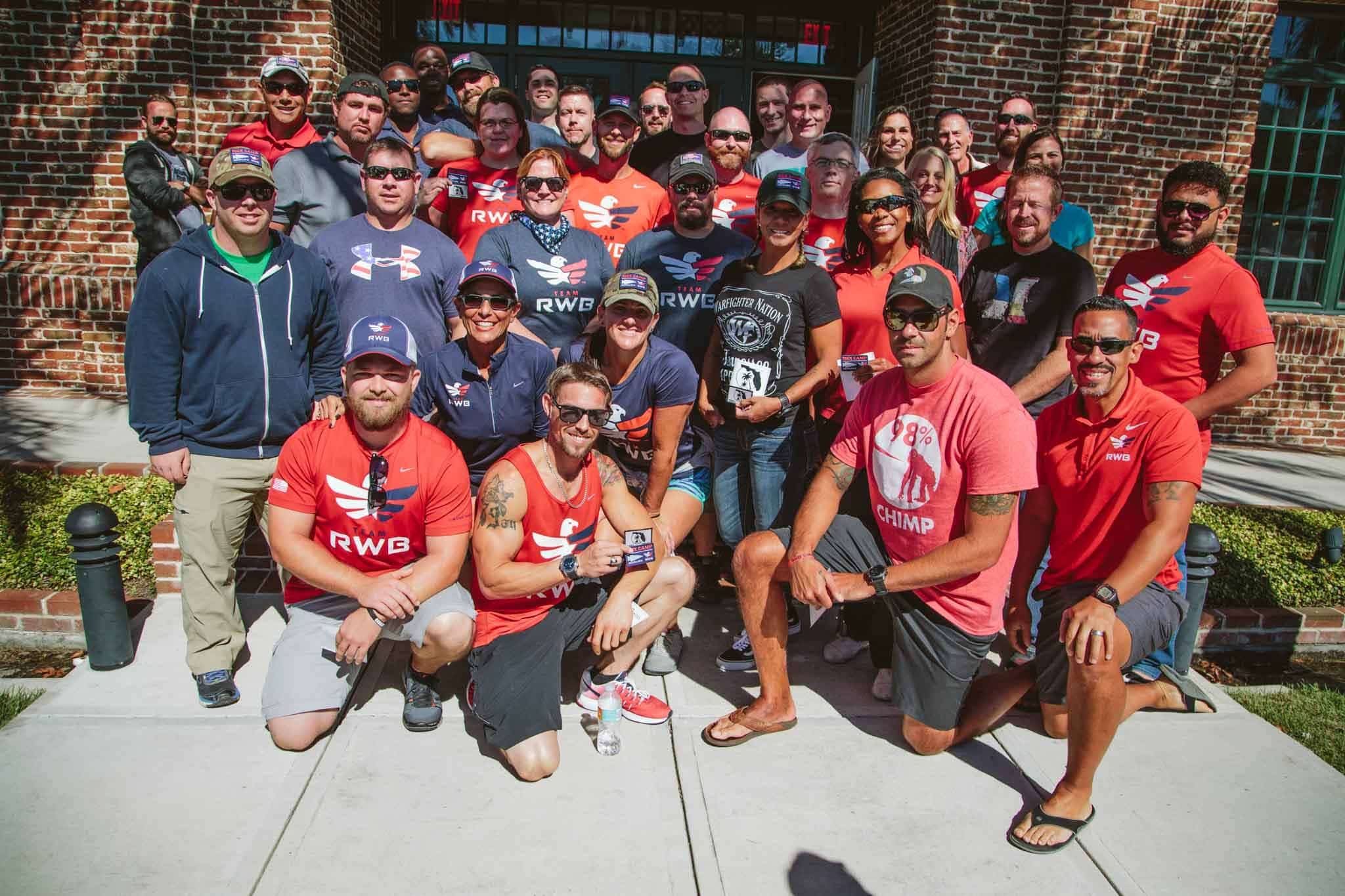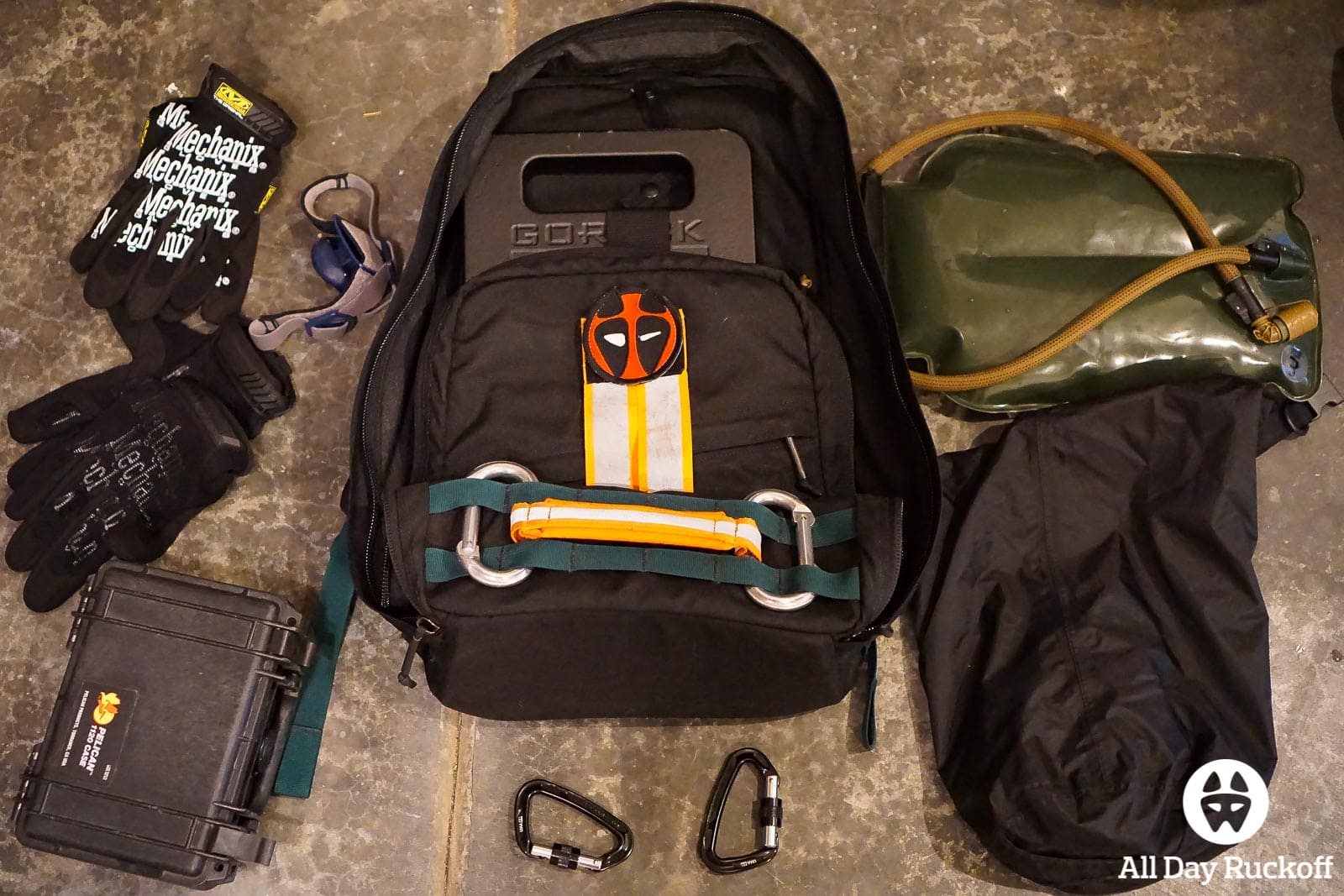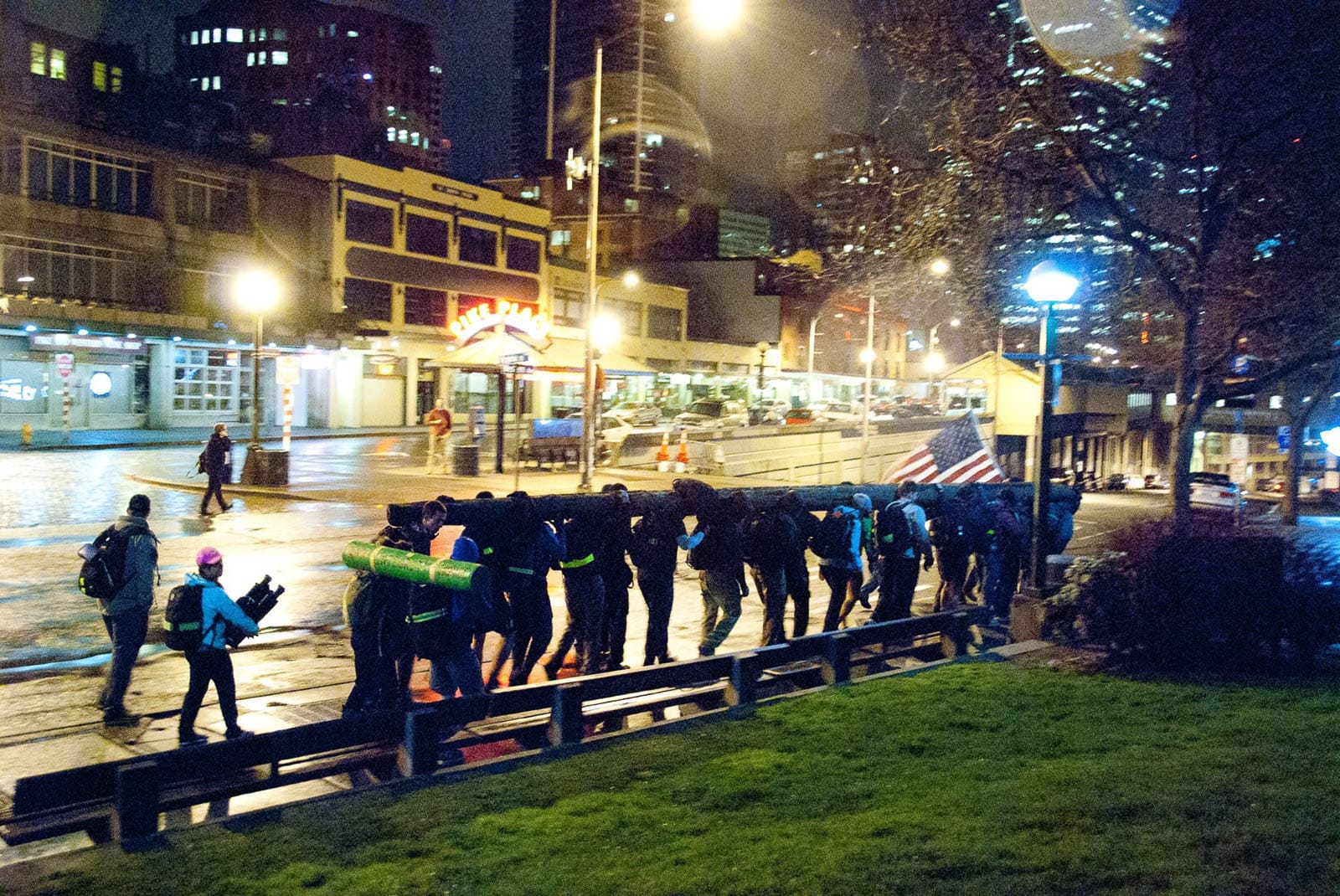
According to GORUCK rucking is “…to move with a rucksack, and implies action, energy, and purpose.” That’s the definition we first read and the one we follow when we talk about rucking. Welcome to All Day Ruckoff and prepare to learn how to ruck for fitness.
Page Updates & Revisions
- 3/24/2017
- Cleaned up information and added a second training plan.
What is Rucking?
Rucking, in it’s simplest form, is moving from location A to location B with your pack. The term comes from the military and the packs they move with weigh a ton… more than what you’ll carry in your standard event. When the military rucks they do it with essential items like weapons, ammunition, etc. When we ruck we do so with weight so that we can achieve a great workout. The main idea is that you will carry heavy weight over a long distance.
How to Practice Rucking

There are many training plans out there for events but not many that focus solely on rucking. We’ve learned that you should always start out with a light (manageable) weight and train up over time in both weight and distance. Avoiding injury is ideal so push it but never too hard so that you can’t train again soon.
You’re starting point is directly determined by how athletic and in shape you are. Nate Morrison recommends starting with items weighing 10% – 20% of your body weight in a backpack over 2 – 4 miles. While that’s good it assumes that you’re in shape and can handle it. Someone starting out at 300 lbs should not be putting 30 to 60 pounds in their pack to start. Our recommendation is you start out at 10 pounds and work your weigh up. Some will increase quicker than others but we recommend everyone new to this start out around 10.

Rucking in itself is not a difficult concept however scheduling your rucks can be a logistical nightmare. Between your personal life, work (and/or school), and the training you’re already doing most people don’t have a spare time to get the training in. A good ruck pace is 15 minute miles which means if you have an 8 mile ruck planned you need to schedule at least 2 hours. I don’t want you to look at the training plan and get discouraged and forgo rucking altogether. Even if you’re only able to fit 4 or 8 miles a week in it will still be incredibly beneficial (some would argue more beneficial than weight training) to your performance in a GORUCK or other ruck event.
How to Create a Weight
Now that you’ve decided that you want to train for an event you’ll need to create some weight to train with. We’re huge fans of simple and easy stuff which is why we recommend GORUCK’s Ruck Plates or using bricks to practice rucking with. These are the most cost efficient weights to create and compact enough to easily store. If you’re training for a GORUCK Light/Challenge/Heavy then you should consider the ruck plates. They meet the weight requirement and don’t take up a ton of space in your pack making them ideal for events. If you do go with bricks then make sure you wrap them so that they don’t damage whatever pack you end up using.
How to Choose a Pack
We recommend the GORUCK Rucker. It can be grabbed off GORUCK’s website for a little over $100 when it’s on sale. We bought ours at retail pricing and don’t regret it so don’t feel bad if you have to too. Other “good” packs we’ve heard of are the Rush 12 and Tactical Tailor’s Removable Operator Pack. Just make sure you get a pack that will not break under the weight you are carrying. There’s not much worse than being 6 miles away from home when a pack breaks and you have to carry 45 lbs of ruck plate home with you.
Where Does the Weight Go?
This might sound like the stupidest question in the world but the answer will save you from a world of discomfort. The obvious answer is in the ruck (duh) but the smarter answer is as close to your back and as high as possible. Try to keep the weight as high as possible by either securing it to the webbing or using a yoga block to prop it up. This will save your lower back from getting tweaked by putting the weight on you upper back and shoulders. If you don’t believe me try rucking 4 miles with the weight in the bottom of the ruck then another 4 miles with the weight in the top. You’ll notice the difference.
Your Training Plan
Now you have your ruck plates (or wrapped bricks) and you know where and how to put them in your ruck. The last step is getting out there and rucking. Great! Now how much weight should you start out with and how far should you go? This exercise will put a lot of strain on your shoulders, chest, and upper back so you want to ensure you follow a smart plan and do it right. Make sure your plan comes from an authoritative source and ramps up in intensity appropriately. You don’t train for a marathon by getting off the couch and running a marathon. You start running a reasonable distance then build up to your desired marathon distance. Like-wise you probably don’t listen to marathon training advice from someone who’s never run a mile in their life… you look for people who have been there and done it before.
Nate Morrison (Army Times) Rucking Plan
Nate Morrison (at Army Times) released a rucking plan for people who are planning on joining the military. I trust Nate Morrison as he’s an Air Force Pararescueman and has a lot of real-world training. This schedule is great for someone who is already in shape and wants to start rucking. If you’re going through a schedule and feel like you’re beginning to injure yourself that would be a good time to step back, look at the schedule, and adjust appropriately.
The following plan involves two rucks a week with the first and second being at the speeds listed respectively in the “Daily Pace” column.
| Week | % of BW | Miles | Daily Pace |
|---|---|---|---|
| 1 | 20 | 5 | Slow/Fast |
| 2 | 20 | 5 | Fast/Slow |
| 3 | 25 | 5 | Slow/Fast |
| 4 | 25 | 5 | Fast/Slow |
| 5 | 30 | 5 | Slow/Fast |
| 6 | 30 | 5 | Fast/Slow |
| 7 | 35 | 5 | Slow/Fast |
| 8 | 35 | 5 | Fast/Slow |
| 9 | 40 | 5 | Slow/Fast |
| 10 | 40 | 5 | Fast/Slow |
| 11 | 40 | 6 | Slow/Fast |
| 12 | 40 | 8 | Slow/Fast |
| 13 | 40 | 10 | Slow/Fast |
| 14 | 40 | 12 | Slow/Fast |
| 15 | 40 | 14 | Slow/Fast |
| 16 | 40 | 16 | Slow/Fast |
All Day Ruckoff Rucking Plan
The first number in the weight section is if you are training for a GORUCK Light and the second is if you’re training for a GORUCK Tough.
| Week | Ruck # | Weight (lbs) (Light/Tough) |
Miles | Goal |
|---|---|---|---|---|
| 1 | 1 | 10/10 | 1 | Get accustomed to carrying a pack with weight. |
| 1 | 2 | 15/15 | 2 | Weekly heavy ruck. |
| 1 | 3 | 10/10 | 4 | Weekly long ruck. |
| 2 | 1 | 15/15 | 2 | Get accustomed to carrying a pack with weight. |
| 2 | 2 | 20/20 | 4 | Weekly heavy ruck. |
| 2 | 3 | 15/15 | 6 | Weekly long ruck. |
| 3 | 1 | 20/20 | 3 | Get accustomed to carrying a pack with weight. |
| 3 | 2 | 25/25 | 4 | Weekly heavy ruck. |
| 3 | 3 | 20/20 | 8 | Weekly long ruck. |
| 4 | 1 | 25/25 | 3 | Weekly light (fun) ruck. |
| 4 | 2 | 30/30 | 4 | Weekly heavy ruck. |
| 4 | 3 | 25/25 | 8 | Weekly long ruck. |
| 5 | 1 | 25/30 | 4 | Weekly light (fun) ruck. |
| 5 | 2 | 30/35 | 5 | Weekly heavy ruck. |
| 5 | 3 | 30/40 | 10 | Weekly long ruck. |
| 6 | 1 | 25/40 | 4 | Weekly light (fun) ruck. |
| 6 | 2 | 25/45 | 4 | Weekly heavy ruck. |
| 6 | 3 | 25/35 | 12 | Weekly long ruck. |
We’ve devised our own rucking plan to get beginners into the mix. We realize Nate’s plan is great for people who are already in shape and training for a bigger event but what about people training for a GORUCK Light or Tough?
Staying Motivated
If you’re having trouble staying motivated then you might want to get some support. Check out our list of Rucking Clubs (and GORUCK’s list) and find a group in your area to train with! There’s more people out rucking than you’d probably imagine.

GORUCK Tough Training Plan
“Make sure you plan for success”

GORUCK Tough Training
“Lean the ins and outs of GORUCK training”

GORUCK Light Training
“Destroy your next GORUCK Light”


Rucking is when a person in the military moves his or her gear in a backpack. When you enlist, your first “encounter” with rucking (or ruck marches) will be in basic training. The goal is to ruck 12 miles (or 19 kilometers) in three hours. Usually, the load will be 35 pounds, but it also depends on the type of load.
So when you jerk, do you walk fast or do you have to run? I haven’t started it yet, other than a few weight runs, so I’d like to start on the right foot. Thanks very much!
I’m new to all this too, and ex-Air Force, so we didn’t ruck. Lol
I just made my 1st sand pill at 15 lbs. How do I get the weight towards the top of the pack? Shove a blanket in the bottom of the pack?
Hi!
No military experience, but love rucking-camping-hunting and so on. When having just one major weight (pill) I recommend blanket, then weight, then blanket. When I pack I try to pack stuff I’m taking to the backwoods and the weight get big fast. I’m 6 foot and prefer my max loads at the bottom of my ribs. Gonna ruck a 50 at 40 on a sidewalk in a week for fun (out and back from my house) for the challenge.
If you’re only carrying sand make it mid back in my experience.
Cheers
Dave
Noob to rucking- looking at the ADR plan, do the weekly long rucks need to be done at fast pace? Or is the point to just cover the distance?
The goal of the longer rucks is to show you how your body (and gear/clothing/shoes) handles long distances and extended workouts. They don’t have to be done fast it’s just important to use those longer rucks to dial everything in and figure out what works for you.
As you ruck more your pace should naturally improve but you shouldn’t be sweating the time on the longer ones.
I just started the whole rucking thing about a month ago, and carry 30lbs right now, 6 days a week, 3.5 miles. I am looking to carry more weight, and looked at your training schedule.
It goes up to 40% of body weight? That would be over 90lbs for me. That seems insane, and not very good for my joints (which are the reason I ruck and don’t run).
Does anyone actually train with that much weight? Even the Goruck website mentions a top weight of 50lbs, for experts.
Tks
It’s important to point out that the chart that goes up to 40% of body weight is “a rucking plan for people who are planning on joining the military.” Not for us mere mortals. I train weekly with 30lbs in my Rucker. However, about about twice a month my team does some sandbag training where I toss on an additional 40lbs on top of the 30, but only for 1-2 miles at a time, rotating the sandbag between teammates.
Completely agree, which is also why I ended up adding the additional ADR plan in there… for us mere mortals who are trying to do this long term, without breaking the body, and where this isn’t part of our job description :)
Thank you for it
I have been backpacking up in the mountains for a couple years and am looking at getting into rucking to add to my workouts between backpacking trips. The question that I keep having relates to the types of packs, and whether these packs have hip-belts. In backpacking, you want much of the weight to rest on your hips rather than your shoulders, and backpacks are designed to drive the weight down to your hips to allow your legs to do most of the work. From what I have read, it kind of seems like this is the opposite in rucking. I understand the idea behind getting the weight up higher in the pack, but is all the weight supposed to rest on your shoulders?
It doesn’t quite rest on your shoulders like a barbell during a squat but it definitely gets the weight off your lower back. The main goal is to get the protect your lower back, which is something a waist belt would do.
The weight belt topic is a fun one. The following are my thoughts on it and should no way be taken as gospel. When hiking you want a weight belt because you’re gaining/losing tons of elevation and need to distribute that weight. Your goal is to get to your destination, enjoy yourself, then get out. Weight belts definitely make it easier.
Most people who ruck do so for a workout. Putting the weight on your shoulders helps build your shoulder muscles in addition to improving your endurance. It also makes it safer when you’re not using a waist belt. I look at it more like doing pull-ups… you can use bands to make it easier but you’re not getting the same workout.
Instead of bricks, dumbbells you can simply use water in 5L/1 gallon plastic containers. Apart from not banging against your back like smaller, high density weights, it is easy to bail out: dump the water anytime you do not need it.
This is quite important when using loaded pack in the mountains. Climb with the loaded weight, dump it either at the top or when you realize it is too risky to continue with the weight throwing you off balance on a steep/slippery trail. Add hiking poles, and you will be able to handle more weight and train more muscles.
Great idea especially for trying to add weight in the mountains… the other plus side is that you can drink it!
Looks the forum is no longer online?
Thanks for the reminder! The page has been updated to include links to Rucking Clubs and GORUCK’s list of Community Groups. People were staying more motivated by posting in their local areas instead of the forum so we ended up shutting the forum down.
I’m not doing it competitively nor will I, just trying to get some workout from the hour I already walk the dog. Thanks for the distributing pack weight advice, the 15lbs of rice settled in the back of the pack has been pulling down on my shoulders. Will try filling the bottom of the pack with bubble wrap and moving the rice bags higher. Nice to see the pics moving through Seattle (as that’s where I am too) I like bags of rice as they don’t have any edges. For me 15% of my weight isn’t very much weight, a problem most guys won’t have.
What’s the best shoes to wear while rucking?
It’s really all preference and there are people who will debate at length on the “best” boots (or shoes) to wear. From my experience two very popular options are the Merrell Moab Ventilator Mid and Rocky C4T boots. With that being said I usually ruck in whatever running shoes I’m wearing at the time. As long as it’s comfortable and doesn’t tear up your feet then you should be good!
I am a paratropper in the U.S Army. Been rucking for a while now and it’s my favorite physical activity by far. I Just completed the units 18 miler yesterday and it was tougher than I expected. I finished under 4 hours 20 minutes but I was surprised at how hard it was for me to go down hills. It got to the point where I would rather go uphill. A lot of what you talk about I learned through trial and error. One thing that helped me was knowing my pace. Since the standard is a 15 minute mile I made my normal walking speed 4 miles an hour. I always look like I’m on the go. And now even on an off day I’m able to do a 12 miler in 2.5 hours.
Jump, Ruck, Eat, Sleep, and Repeat
I am a midshipmen at the United States Merchant Marine Academy and I have been rucking for a month or so. I am interested in going Active Duty after graduation and I know it’s a great way to stay in shape/train. How many rucks per week do you recommend (ex: two/three x five mile rucks). Great article, very helpful. Thanks!
I try for two as it’s a lot more manageable when worked in with another workout routine. However, I try and get one longer one in there on a weekend once a month or so to remember what those feel like. Hope that helps!
So when rucking, are you walking swiftly or is there running involved? I haven’t started this, except for a few weighted runs, so I would like to start off on the right foot. Thanks!
There are definitely some people who run but we always swiftly walk. A swift walk is much safer and better for your knees. The goal is no injury :)
I think it’s funny they’re on an escalator in the second picture of this article. Just sayin, great article by the way. Discovered rucking recently and really enjoy it. Excellent alternative to pounding out a run.
One of the reasons I chose it haha. That’s probably one of those smarter not harder examples.
Does wearing a weighted vest count? I feel like this might be a dumb question….?
Definitely not a dumb question! I can’t think of any reason a weight vest wouldn’t work at the lower weight levels. Once you get to the higher percentages though it might be tough to find one that can handle it. Hope that helps!
My age is 67 plus but I am physically fit and have no disease. Can I start rucking?
That would be up for a doctor to determine but it’s about the same as hiking so if you’re currently doing any of that you should probably be fine. That being said the safest bet is to ask the doc.
Are those miles total in a week, or all in one ruck? What do you mean by slow/fast pace?
Those are total miles per ruck, so the weekly number would be double. A “slow” pace “should allow you to hold a steady conversation through the march” and a “fast” pace “should limit you to speaking in quick bursts, and you should be just out of breath the entire time. You should not be marching as fast as you can — you have to build load-bearing capacity first.”
More information on this plan can be found here.
Slow is smooth.
Smooth is fast.
What have you heard about brick weight? I see in your Flickr that you use the cored bricks. I have 6 that weigh out at about 26 and then 6 solid bricks that top out at 37.
Also…what are the straps you use to keep them in place in the ruck?
Thanks for the tips!!
I actually have both sets of bricks. There’s been a lot of debate on the GORUCK Tough group as to whether using bricks with holes is cheating or not. I decided to pick six up to see if they really are that much lighter (and I also wanted to write a post on how I wrap them.) The six with holes top out around 24 pounds and the six without (from Home Depot) weigh in at 34 pounds.
I bought the straps from https://www.strapworks.com/ but if you’re crafty with a sewing kit you can buy the metal ends and bulk straps at an army surplus store for a bit cheaper. The straps came out to $14 for the 3 of them and $6 for shipping.
If you ain’t cheating, you aren’t trying!!!